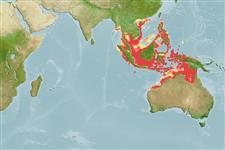Environment: milieu / climate zone / depth range / distribution range
Écologie
marin récifal; profondeur 10 - 80 m (Ref. 5222). Tropical; 21°N - 21°S, 94°E - 143°E (Ref. 5222)
Western Central Pacific: known only from tropical waters, from Thailand and the Philippines to northern Australia.
Length at first maturity / Taille / Poids / Âge
Maturity: Lm ?, range 13 - ? cm
Max length : 40.0 cm TL mâle / non sexé; (Ref. 48635)
Épines dorsales (Total): 11; Rayons mous dorsaux (Total): 14-16; Épines anales 3; Rayons mous anaux: 8. Preopercle with two to four greatly enlarged serrae at its angle; upper edge of the operculum straight; nostril sub equal. Maxilla reaches to or slightly past the vertical a rear edge of the eye. Pectoral fins not fleshy. Pyloric caeca 7 or 8. Color of head and body pale grayish brown with 5 dark brown bars on the body and 1 on nape. Scattered pale spots may be present on body and some faint small brown spots are often on the edges of the dark bars. The soft dorsal, caudal, and pelvic fins dusky gray, the pectoral fins grayish or orange-red. The jaws and ventral parts of the head sometimes pale reddish brown.
Common on silty sand or mud bottoms. Its preference for soft-bottom habitats may account for its restricted distribution and absence at oceanic islands. Feeds on small fishes and crustaceans (Ref. 89707).
Life cycle and mating behavior
Maturité | Reproduction | Frai | Œufs | Fécondité | Larves
Heemstra, P.C. and J.E. Randall, 1993. FAO Species Catalogue. Vol. 16. Groupers of the world (family Serranidae, subfamily Epinephelinae). An annotated and illustrated catalogue of the grouper, rockcod, hind, coral grouper and lyretail species known to date. Rome: FAO. FAO Fish. Synop. 125(16):382 p. (Ref. 5222)
Statut dans la liste rouge de l'IUCN (Ref. 130435)
Menace pour l'homme
Harmless
Utilisations par l'homme
Pêcheries: commercial
Plus d'informations
RéférencesAquacultureProfil d'aquacultureSouchesGénétiqueElectrophoresesHéritabilitéPathologiesTraitementNutrientsMass conversion
CollaborateursImagesStamps, Coins Misc.SonsCiguateraVitesseType de nageSurface branchialeOtolithesCerveauxVision
Outils
Articles particuliers
Télécharger en XML
Sources Internet
Estimates based on models
Preferred temperature (Ref.
123201): 26.8 - 29.1, mean 28.3 °C (based on 926 cells).
Phylogenetic diversity index (Ref.
82804): PD
50 = 0.5000 [Uniqueness, from 0.5 = low to 2.0 = high].
Bayesian length-weight: a=0.01318 (0.00828 - 0.02098), b=3.05 (2.92 - 3.18), in cm total length, based on LWR estimates for this species & Genus-body shape (Ref.
93245).
Niveau trophique (Ref.
69278): 3.8 ±0.4 se; based on diet studies.
Generation time: 2.2 ( na - na) years. Estimated as median ln(3)/K based on 1
growth studies.
Résilience (Ref.
120179): Milieu, temps minimum de doublement de population : 1,4 à 4,4 années (K=0.16).
Fishing Vulnerability (Ref.
59153): Low to moderate vulnerability (26 of 100).
Nutrients (Ref.
124155): Calcium = 37.5 [18.4, 75.6] mg/100g; Iron = 0.574 [0.309, 1.201] mg/100g; Protein = 18.6 [17.1, 19.9] %; Omega3 = 0.136 [0.085, 0.214] g/100g; Selenium = 38.1 [21.1, 66.9] μg/100g; VitaminA = 158 [44, 554] μg/100g; Zinc = 1.34 [0.92, 1.89] mg/100g (wet weight); based on
nutrient studies.
